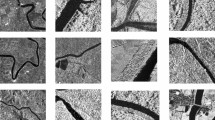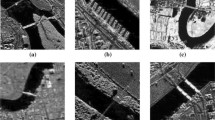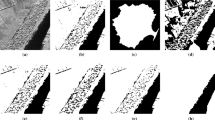Abstract
Adaptive localizing region-based active contour model driven by Laplacian kernel-based fitting energy is proposed for improving the efficiency and accuracy of synthetic aperture radar (SAR) river image segmentation in the paper. Defining regional energy functional that depends on the Laplacian kernel distance which is robust and non-Euclidean, Laplacian kernel distance is nonlinear transformation, whose transformed space can be linear classification. Additionally, providing the novel calculation for fitting center which relies on the local and global gray value, furthermore, the adaptive selection function of local radius is made. By using both of them, the proposed model can improve the accuracy of the fitting center and local region; afterward, the evolution of the curve can achieve the global optimal and be controlled better. Finally, in order to speed up the computation of proposed model, the localized region surrounded by adjacent four pixel points on the evolution curve can be replaced by the localized region of the intermediate pixel. The proposed model has been successfully applied to river channel extraction from synthetic aperture radar (SAR) images with desirable results. Comparisons with other state-of-the-art approaches demonstrate the great performances of the model.











Similar content being viewed by others
References
Yu XS, Wu CD, Chen DY et al (2012) River detection in remote sensing image based on multi-feature fusion. J Nottheastern Univ Nat Sci 33(11):1547–1550
Wang C, Huang FC, Tang XB et al (2012) A river extraction algorithm for high-resolution SAR images with complex backgrounds. Remote Sense Technol Appl 27(4):516–522
Bharathi PT, Subashini P (2013) Texture based color segmentation for infrared river ice images using K-means clustering. In: 2013 International conference on signal processing, image processing and pattern recognition, 298–302
Zhao JJ, Yu H, Gu XG et al (2010) The edge detection of river model based on self-adaptive Canny Algorithm and connected domain segmentation. In: 2010 8th World congress on intelligent control and automation, 1333–1336
Chan TF, Vese LA (2001) Active contours without edges. IEEE Trans Image Process 10(2):266–277
Kass M, Witkin A, Terzopoulos D (1988) Snakes: active contour models. Int J Comput Vision 1:321–331
Kim W, Kim C (2013) Active contours driven by the salient edge energy model. IEEE Trans Image Process 22(4):1667–1673
Dzyubachyk O, van Cappellen WA, Essers J et al (2010) Advanced level-set-based cell tracking in time-lapse fluorescence microscopy. IEEE Trans Med Imaging 29:852–867
Vasilevskiy A, Siddiqi K (2002) Flux maximizing geometric flows. IEEE Trans Pattern Anal Mach Intell 24(12):1565–1578
Li C, Kao C, Gore JC, Ding Z (2007) Implicit active contours driven by local binary fitting energy. In: IEEE conference on computer vision and pattern recognition, 1–7
Zhang K, Song H, Zhang L (2010) Active contours driven by local image fitting energy. Pattern Recogn 43(4):1199–1206
Li C, Kao CY, John G et al (2106) Minimization of region-scalable fitting energy for image Segmeatation. In: SAI computing conference, 255–263
Zheng Q, Dong E, Cao Z (2014) Active contour model driven by linear speed function for local segmentation with robust initialization and applications in MR brain images. Sig Process 97(4):117–133
Lankton S, Tannnenbaum A (2008) Localizing region-based active contours. IEEE Trans Image Process 17(11):2029–2039
Song Y, Wu YQ, Dai YM (2016) A new active contour remote sensing river image segmentation algorithm inspired from the cross entropy. Digit Signal Proc 48:322–332
Elisee IM, Juan GA, Arturo GP et al (2017) Localized active contour model with background intensity compensation applied on automatic MR brain tumor segmentation. Neurocomputing 220(S1):84–97
Huang C, Zeng L (2016) Level set evolution model for image segmentation based on variable exponent p-Laplace equation. Appl Math Model 40(S1):7739–7750
Niu S, Chen Q, Sisternes LD, Ji Z, Zhou Z (2017) Robust noise region-based active contour model via local similarity factor for image segmentation. Pattern Recogn 61(S1):104–119
Li XM, Wei WH, Fan YF (2016) Segmentation of brain tumor based on gaussian probability localizing local region active contour model. J Med Image Health Inf 6(7):1741–1745
Wang Y, Xiang S, Pan C, Wang L, Meng G (2013) Level set evolution with locally linear classification for image segmentation. Pattern Recogn 46(6):1734–1746
Zhang CC, Song ST, Wen XT et al (2015) Improved sparse decomposition based on a smoothed L0 norm using a Laplacian kernel to select features form fMRI data. J Neurosci Methods 245:15–24
Gao GG, Wen CL, Wang HB (2017) Fast and robust image segmentation with active contours and student’s-t mixture model. Pattern Recogn 63(S1):71–86
Li C, Huang R, Ding Z, Gatenby JC et al (2011) A level set method for image segmentation in the presence of intensity inhomogeneities with application to MRI. IEEE Trans Image Process 20(7):2007–2016
Li C, Xu C, Gui C, Fox MD (2010) Distance regularized level set evolution and its application to image segmentation. IEEE Trans Image Process 19(12):3243–3255
Dietenbeck T, Alessandrini M, Friboulet D et al (2010) A free software for the evaluation of image segmentation algorithms based on level-set. In: Proceedings of the IEEE international conference on image processing. 665–668
Acknowledgements
This work is partially supported by National Natural Science Foundation of China under Grant No. 61573183; Key Laboratory of Port, Waterway and Sedimentation Engineering of the Ministry of Transport.
Author information
Authors and Affiliations
Corresponding author
Electronic supplementary material
Below is the link to the electronic supplementary material.
Rights and permissions
About this article
Cite this article
Ni, K., Wu, Y. Synthetic aperture radar river image segmentation using improved localizing region-based active contour model. Pattern Anal Applic 22, 731–746 (2019). https://doi.org/10.1007/s10044-018-0683-6
Received:
Accepted:
Published:
Issue Date:
DOI: https://doi.org/10.1007/s10044-018-0683-6




